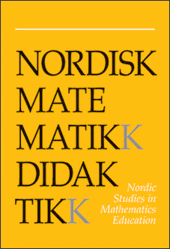 Volume 23, No 3-4, November 2018
Volume 23, No 3-4, November 2018
e-NOMAD
Tamsin Meaney and Toril Eskeland Rangnes
Language diversity in mathematics education in the Nordic countries 2008–2018
Eva Norén and Petra Svensson Källberg
Fabrication of newly-arrived students as mathematical learners
Petra Svensson Källberg
Identity formations as mathematical learners in the context of transition
Marie Sjöblom
Developing mathematical reasoning by using questions in a multilingual mathematics classroom
Maria Ahlholm and Päivi Portaankorva-Koivisto
The language factor – what exactly is it? Bilingual speakers of Russian and Finnish solving mathematical tasks
Jöran Petersson
Newly- and early-immigrated second-language students’ knowledge of arithmetic syntax
Hilja L. Huru, Anna-Kaisa Räisänen and Anita Movik Simensen
Culturally based mathematics tasks: a framework for designing tasks from traditional Kven artefacts and knowledge
Mette Hjelmborg and Ane Fleischer
En registeranalyse af centrale matematiske begreber i en grønlandsk kontekst
Anne Birgitte Fyhn, Ellen J. Sara Eira, Ole Einar Hætta, Inga Anne Marit Juuso, Siv Ingrid Nordkild og Ellen Margrethe Skum
Bishop Sámegillii – utfordringer ved oversetting av matematikkdidaktisk fagterminologi
Dorota Lembrér
Polish parents’ views on mathematics activities at home and in Swedish preschools
Troels Lange and Tamsin Meaney
Talking about mathematics in two languages: Can parental views inform the development of digital games for young children?
Andrea Eikset and Tamsin Meaney
When does a difference make a difference? Teaching about language diversity in mathematics teacher education
Susanne Prediger
Multilingual issues in Nordic mathematics education – What is achieved and where to go next?
